October itinerary in Japan Day 6 (Kyoto Day 1 Meal edition)
(Monday, October 25)
Table of contents
1. Craft beer “Tango Kingdom Seaside Bar”
1. Craft beer “Tango Kingdom Seaside Bar”
After exiting the ticket gate of Amahashidate Station, turn right and you will find “Tango Kingdom Seaside Bar”, where you can drink draft beer of craft beer. Isn’t it rare to find a station where you can drink draft beer of craft beer?
The craft beer provided by “Tango Kingdom Seaside Bar” is TANGO KINGDOM Beer‘s beer, which is produced at the brewery in the roadside station Tango Kingdom “Food Miyako”. The label design uses the symbol of the Tango region, “Tango Nanahime”. I think it’s a very fashionable label.
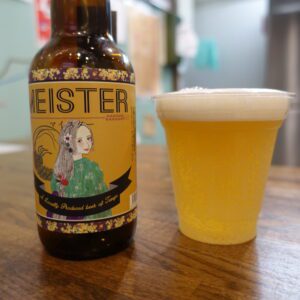
There is only one type of draft beer that can be drunk at “Tango Kingdom Seaside Bar”, but many types are sold in bottles. I drank draft beer and had a bottle of “MEISTER” lent for shooting. “MEISTER” was a delicious beer with a clean and clear taste.
2. Lunch “Hyoshiro”
I took a bus from Amanohashidate to Ine, and after arriving in Ine, I had lunch at “Hyoshiro”. “Hyoshiro” is the No. 1 restaurant in the Tabelog ranking in Ine. It was a rainy day on Monday, but the restaurant was almost full.
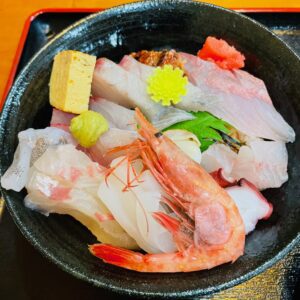
I had “Kaisen-don (seafood bowl) ” (Yen1,500) and “One Heshiko Sushi” (Yen200). The seafood bowl was delicious above average with lots of ingredients such as Spanish mackerel, red sea bream, gurnard, and great amberjack. Japan Fisheries Cooperatives has selected the Spanish mackerel (season: October-December) as the autumn “PRIDE FISH” in Kyoto Prefecture.
What impressed me was the “Heshiko sushi”. Mackerel heshiko is a local dish of Fukui prefecture as I introduced before, but it is also a local dish in Ine where many mackerels are caught. In addition to mackerel heshiko, “heshiko sushi” is also a local dish in Ine.
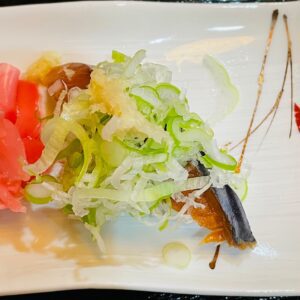
For “Heshiko sushi” of “Hyoshiro”, remove the saltiness of “Heshiko” with vinegar etc. and put green onions and ginger on it. In the photo, the “heshiko” is not clearly visible due to the green onions and ginger, but it was a mysterious taste that I had never eaten before. The “Heshiko” I ate in Fukui was very salty, so I ordered only one “Heshiko sushi” at “Hyoshiro”. However, if I knew it was so delicious, I should have ordered “Heshiko Sushi” for one person (8 pieces) instead of the seafood bowl. For me, it was so delicious that I wanted to revisit Ine just to eat “Heshiko sushi”. It is the real pleasure of traveling to meet such new tastes.
3. Dinner “Fukutei”
After arriving at Himeji Station, I had dinner at “Fukutei“. “Fukutei” is a restaurant and izakaya that offers fresh fish, mainly from Harima Nada (Sea of Harima). It also serves many local sakes. The food was very delicious, the service of the staff was good, and the inside of the store was clean and I got a very good impression.
Harima Nada is not well known nationwide, but it is a good fishing ground where fishermen can catch delicious fish such as red sea bream and Mako garei ( flatfish). Harima Nada corresponds to the sea area surrounded by Shikoku (south side), Shodoshima (west side), Iejima Islands (north side), and Awaji Island (east side) in the Seto Inland Sea.
There are many sake breweries in Himeji. There are 11 breweries that are members of the Himeji Brewer’s Association. Nadagiku Sake Brewery Co.,Ltd. and YAEGAKI Sake&Spirits, Inc. are famous nationwide. I want many people to visit Himeji, which is blessed with delicious sake and delicious seafood.
This time, I ordered a Densuke conger eel hot pot, assorted sashimi, parboiled Densuke conger eel, and steaming matsutake mushrooms in a clay bottle.
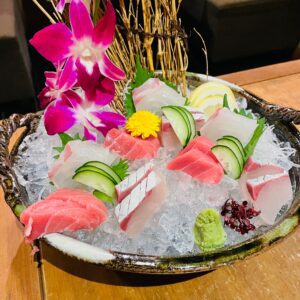
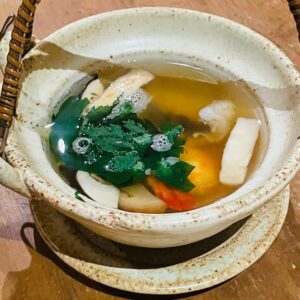
Among the conger eels, the one with a size of 300g or more is called “Densuke Anago (conger eel)” in Hyogo prefecture. Since the bones are thick, you can’t eat it unless you cut the bones like a conger pike. Therefore, it is sometimes eaten by parboiled, which is rare in conger eels. The main production areas of “Densuke Anago (conger eel)” are Akashi and Awaji Island.
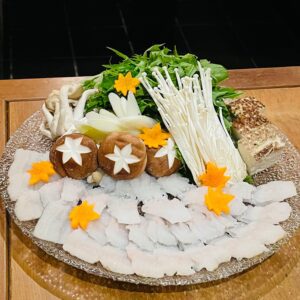
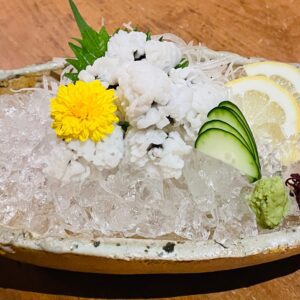
The origin of “Densuke Conger Eel” seems to come from a person named Densuke , “Big and Useless” in the old tale of Hyogo Prefecture. The oversized conger eels have thick bones and are difficult to eat, so the fishermen had thrown them away. It’s the same as the Otoro tuna, and it’s an example of the ingredients that were thrown away in the past are now high-class ingredients.
Note: The departure / arrival times, fees, and admission fees for transportation listed in the text are as of the time of writing the BLOG. Please check for yourself when you go on a trip as it may change in the future.